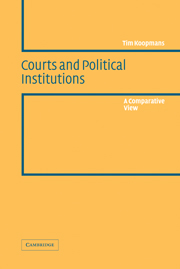Book contents
- Frontmatter
- Contents
- Preface
- Table of cases
- List of abbreviations
- 1 Introduction
- 2 The Sovereignty of Parliament
- 3 Judicial review of legislation
- 4 The growth of judicial power
- 5 The limits of judicial review
- 6 The legality of administrative action
- 7 Courts and governments
- 8 Courts and individual rights
- 9 Techniques of judicial protection
- 10 A glance at the future
- Select bibliography
- Index
3 - Judicial review of legislation
Published online by Cambridge University Press: 26 February 2010
- Frontmatter
- Contents
- Preface
- Table of cases
- List of abbreviations
- 1 Introduction
- 2 The Sovereignty of Parliament
- 3 Judicial review of legislation
- 4 The growth of judicial power
- 5 The limits of judicial review
- 6 The legality of administrative action
- 7 Courts and governments
- 8 Courts and individual rights
- 9 Techniques of judicial protection
- 10 A glance at the future
- Select bibliography
- Index
Summary
The constitutional model
The opposite of the parliamentary model is the constitutional model: it is at the other end of the scale. In the constitutional model, a parliament cannot be ‘sovereign’ or ‘supreme’ in any sense of these words, because its legislation has to be compatible with higher law, in particular with the Constitution, and this compatibility will not be assessed by the parliament itself, but by a judicial body.
The American system of judicial review of legislation comes very close to this model. In the United States, any court to which a case or controversy has been brought will have to examine the arguments of the parties concerning the compatibility of statutes with the Constitution. If the court comes to the conclusion that a statute is unconstitutional, it will not apply that statute (it will ‘strike down’ the statute, in professional legal language). American reality shows, however, a somewhat different picture, because important cases on the interpretation of the Constitution will nearly always be referred to the US Supreme Court in Washington. It is true that this Court is only the highest appeal court in the hierarchy of federal courts, and that each of the fifty states has its own hierarchy of courts, with its own supreme court; but an appeal to the Court from state supreme courts is always possible if the compatibility of a state statute with the federal Constitution is raised.
- Type
- Chapter
- Information
- Courts and Political InstitutionsA Comparative View, pp. 35 - 62Publisher: Cambridge University PressPrint publication year: 2003

